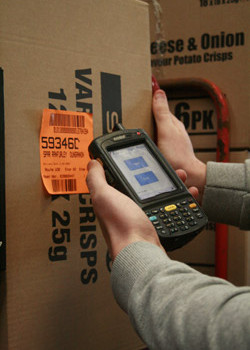Voice of reason

Voice-based warehouse technology is catching on in Ireland and many businesses are now discovering the real benefits it delivers.
18 May 2009
For those not yet familiar with it, voice technology in warehousing uses speech recognition and speech synthesis software to communicate with the warehouse management system (WMS).
In other words, operatives can literally speak to the WMS and receive instructions back from it, via a headset, allowing them to pick orders with the use of two hands, in a much faster and more efficient manner.
Although it’s been getting considerable attention in Ireland in recent times, the technology is by no means new.
In fact, it’s been fairly well established for at least 10 years. In its most common application, order picking, it uses a wireless portable computer (voice terminal) and headset to give verbal instructions to the warehouse operative, via radio frequency (RF) or local area network (LAN). The operative verbally confirms each action once completed, and the software then interprets their speech to record the data in the WMS.
To migrate to a voice-based system, it must be integrated to the existing WMS or ERP (enterprise resource planning), creating a fully automated system that controls all the data related to the warehouse processes. Companies such as Heavy RF, providers to ADM Londis among others, have also undertaken new projects in the past 12 months to integrate mobile systems such as Epod (electronic proof of delivery) as a further extension of these systems to deliver further value and costs savings across the supply chain.
The benefit of this impressive gadgetry? Order picking accuracy in the range of 99.99% is typically expected, for starters. Which, when moving from a paper-based picking system, usually represents up to 20% improvement. ADM Londis customer operations director, Claude Tonna Barthet cited several major benefits to the group’s support office and, more importantly, its retail customers, when it migrated from a paper-based operation to its new voice technology system.
“Pickers are directed in the most efficient way to pick their orders and warehouse stock levels are updated
automatically as soon as product is picked, ensuring that stock records are always up to date,” he explains. “This is far removed from the previous paper based picks where pickers had to effectively guess the most efficient way to pick an order, and also whether there would be any stock of a particular product in the pick location when they got there.”
Greater efficiency, happier customers
Last year Londis and TDG Logistics invested €650,000 to implement voice technology at the group’s Johnstown warehouse centre. According to Tonna Barthet there have been major benefits in the new voice picking system: pick
ers are employed more efficiently thanks to accurate instructions; real time updating with every pick means lower stock h
Increased productivity
olding, as the system can calculate stock requirements based on up-to-date information; operatives achieve improved pick accuracy as they must verbally confirm the picked product to the system before it accepts that the order has been picked; Londis achieves higher levels of retailer satisfaction as “what they order is very much what they get”; and Londis retailers benefit from reduced cost of warehouse product as a result of these efficiencies.
Ultimately, driving efficiency to drive business is what makes the investment a worthy and sustainable initiative. Pat McGarry, group operations director of Hendersons in Northern Ireland, says it was similar motivation that drove the group to implement voice picking in all three of its DCs: “The desire to improve accuracy and hence customer service was the main motivation behind Hendersons making the switch to voice-based WMS. Benefits were seen both in the cost of running the business and also in the improvement in the service we offer our customers; there is significant on-shelf availability improvement.”
Like Londis, Hendersons used a paper-based (sticky label) system in its warehouse prior to installing voice technology. A “tried and tested” system, McGarry points out, but one that is prone to error. “We wanted to improve not only the efficiency levels but also the accuracy of our warehouse operations. We place a high priority on our service levels and it’s important that our retailers receive what they want, when they want it, in full and on time.”
Hendersons selected voice software provider Zetes to interface its solutions with the group’s own existing WMS. “In our fresh food warehouse…we had our own bespoke system, which did not have the functionality needed to support voice picking,” explains McGarry. In order to fully migrate to voice therefore, Hendersons had to first install a piece of middleware, known as MEDEA, which had both warehouse functionality and could interface with the new voice software.
“We introduced MEDEA, which gave us some warehouse management functionality, and then over layered this with voice picking into fresh foods. Accuracy with these kinds of temperature-sensitive and time-sensitive goods is critical to avoid wastage and therefore the implementation of an effective system was essential.”
Straight away the impact on productivity of improved efficiency and speed, which McGarry says was a secondary ambition to improving service levels, was quantifiable; in the order of 15% increase in productivity. Such results came as a welcome surprise and “excelled our expectations.” In addition he says: “We were very pleased with not only the improvement in productivity but also the take-up by our employees…which would be down to the user-friendly nature of the system and the training received.”
Total spend for Hendersons came to around €300,000 on the MEDEA system in its fresh food warehouse, and around €150,000 for the Epod. The benefit of the investment was not only surprising but delivered surprisingly fast, with return on investment reached within 18 months, according to McGarry.
Beyond the warehouse
With such efficiency in the warehouse, it’s a logical progression to extend the technology to outside logistical operations, which in Hendersons’ case meant introducing the Epod, a handheld device for tracking orders and updating the WMS, after the goods have left the warehouse. “What we wanted was to go paperless with our deliveries as well. So basically the information that was on the paper we put onto the handheld terminal, the Epod,” explains McGarry.
The Epod serves several functions. It completes the driver’s safety check and records and uploads the information to the main server, so any vehicle defects are picked up immediately. As the driver logs on, the Epod receives his activities for the day, route schedule, inventory, and as the deliveries are made the Epod scans the barcodes of containers coming off the vehicle, checking that the customer is getting the right goods.
“It eradicates the element of human error. The Epod knows at a particular destination a certain barcode is allowed to be unloaded. If the driver unloads the wrong barcode it stops him and he has to go and investigate it. It also indicates if there are any returns from the customer or if there are any credits as well.”
Not too high-tech
In spite of the fact that this technology has been around for some years, Ciaran Lavelle, sales manager Heavy RF, says it remains a dynamic area and one that is under-exploited in Ireland. “Voicing is quite exciting. It’s been part of the offering for four years and it’s half our revenue already; it’s a rapidly growing part of the business.”
Lavelle says however that businesses are “a little bit behind in Ireland,” which in many cases is down to a misconception that voice picking is “too high-tech.” “Clients say, I’ll go for barcode scanning and in a few years I might go to voice, but that really doesn’t make sense; there’s no point in doing that at all. Scanning gives accuracy but it’s a little bit slower. Voice gives both speed and accuracy.”
“We supply a product set from US company Vocollect (www.vocollect.com); we combine their technology with a locally developed software system called VocalPoint, where software is required, and this combination delivers a very high level of efficiency and accuracy to warehouse operations.” The net result is a lean operation that allows management to make strategic plans based on real information.
Multiple capabilities, different needs
Lavelle advises that companies thinking of upgrading their WMS but unsure of their budgets should begin with some independent consultancy to identify the “pain points” and areas where the quickest return on investment can be made. “Given the right approach and a real partnership between the parties, a company with a warehouse staff of between five to 10 people can realise genuine cost savings that would give them the ability to better survive the current financial turmoil.”
Furthermore, having taken on a new voice-based solution, its capabilities can be expanded over time to deliver greater benefits, such as Hendersons’ adoption of the Epod. According to Pat McGarry, the next phase will be to interface the system with the group’s payroll – as the Epod can track the driver’s earnings according to the existing productivity scheme – and eventually to incorporate invoicing also.
Although Londis’ software is currently being used to its full capacity, the group is also looking at opportunities “to extend the reach of efficiency generating technologies into all areas of the supply chain and our business in general,” says Claude Tonna Barthet. For instance, in a major IT initiative for the group, Londis is currently rolling out a Microsoft Customer Relationship Management application, Londis ASSIST, a key benefit of which is “the possibility of closer team working between Warehousing and Logistics and our Customer Service department, ensuring that our retailer service level expectations are met and exceeded.” The €200,000 investment was recently unveiled at Londis’ Johnstown headquarters in Kildare.



 Print
Print






Fans 0
Followers